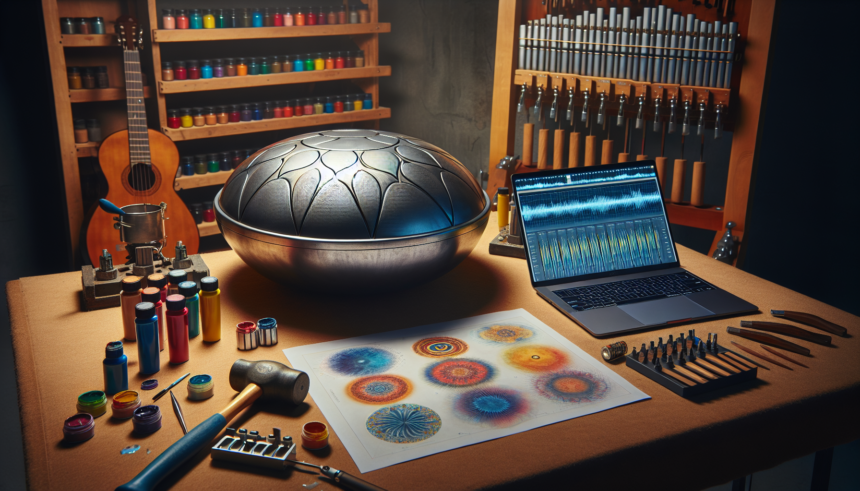The handpan is a unique and captivating musical instrument that has drawn the attention of music enthusiasts and professionals alike. Its distinct resonant tones and ergonomic design make it not only a delight to the ears but also pleasing to the eyes. However, the process of customizing a handpan involves balancing two crucial elements: aesthetics and acoustics. This article delves deep into the art and science of handpan customization, offering insights into how craftsmen achieve this delicate balance and what users can expect from a personalized handpan.
The Art of Handpan Aesthetics
Aesthetics play a vital role in the allure of a handpan. While the primary function of the instrument is to produce sound, its visual appeal cannot be understated. The design, color, texture, and finishing touches contribute to the overall experience of playing and owning a handpan.
1. Design and Shape
The design of a handpan is the foundational element of its aesthetics. Handpans are typically crafted from a convex steel shell, and the shape can vary subtly from one instrument to another. The curvature and size of the handpan can influence both its visual appeal and its acoustic properties.
2. Surface Treatments and Finishes
Surface treatments play a significant role in the look of the handpan. Some popular finishes include:
- Nitride Finish: Provides a subtle, matt black appearance while enhancing the durability of the steel.
- Raw Steel Finish: Maintains the natural look of the steel with visible hammer marks, adding an element of craftsmanship and authenticity.
- Patina Finish: Offers a unique, aged look by chemically treating the surface to achieve various colors and patterns.
- Painted and Lacquered Finishes: Available in a variety of colors and provide a glossy, polished appearance.
3. Engravings and Imprints
Engravings and imprints are another way to personalize a handpan. Artisans can etch intricate designs, symbols, or even custom patterns onto the surface. These engravings not only enhance the visual appeal but also add sentimental value, making the instrument truly one-of-a-kind.
The Science of Handpan Acoustics
While aesthetics are important, the primary function of a handpan is to produce beautiful sound. The acoustic properties of a handpan depend on several factors, including the material, tuning, and construction techniques. Achieving the perfect balance between visual beauty and acoustic excellence is a challenging yet rewarding endeavor for handpan makers.
1. Material Selection
The type of steel used in making a handpan significantly affects its sound. Common materials include:
- Stainless Steel: Known for its brightness and resistance to rust, it provides a clear and long-sustaining tone.
- Nitrided Steel: Offers a softer, warmer sound and is resistant to corrosion.
- Raw Steel: Often used for its raw, organic tones and is generally more susceptible to rust but can be treated to enhance durability.
Each material has its own unique acoustic properties, and the choice largely depends on the player’s preference for sound and maintenance requirements.
2. Tuning and Note Layout
Tuning is the heart of the handpan’s acoustic properties. Expert tuners meticulously shape each note area, ensuring that the instrument produces harmonious and resonant tones. The layout of the notes on the handpan can also influence playability and sound. Some common scales include:
- D Major: Popular for its bright and energetic sound.
- C Minor: Known for its deep and melancholic tones.
- Ake Bono: A Japanese scale that provides a mystical and peaceful sound.
3. Construction Techniques
The construction techniques employed by the artisan play a crucial role in the final sound of the handpan. This includes the hammering process, the shaping of the shells, and the treatment of the steel. Each step requires precision and expertise to ensure that the handpan not only looks beautiful but also sounds exquisite.
Balancing Aesthetics and Acoustics
Balancing the aesthetics and acoustics of a handpan is a complex process that requires both artistic vision and technical expertise. Here are some key considerations artisans and musicians must keep in mind:
1. Holistic Design Approach
A holistic approach to design ensures that neither aesthetics nor acoustics is compromised. Handpan makers often work closely with musicians to understand their specific needs and preferences. This collaboration results in an instrument that not only looks beautiful but also meets the acoustic expectations of the player.
2. Precision and Consistency
Precision in crafting and consistency in tuning are essential for a balanced handpan. Artisans use specialized tools and techniques to maintain uniformity across the instrument. This ensures that each note is perfectly tuned and the overall sound is harmonious.
3. Customization Options
Offering a range of customization options allows players to have a handpan that reflects their personal style and sound preferences. This includes choice of material, surface finish, note layout, and engravings. Handpan makers often provide samples and prototypes to help players make informed decisions.
4. Iterative Process
Creating a custom handpan is often an iterative process. Artisans may produce several versions and make adjustments based on feedback. This iterative approach ensures that the final product is a perfect blend of aesthetics and acoustics.
Conclusion
Handpan customization is an intricate process that requires a delicate balance between aesthetics and acoustics. The visual appeal of the instrument enhances the overall experience of playing, while the acoustic properties are paramount to its function as a musical instrument. By collaborating with skilled artisans, musicians can achieve a personalized handpan that reflects their individual style and produces beautiful, resonant tones. As the popularity of handpans continues to grow, the demand for customized instruments is likely to increase, paving the way for even more innovative designs and sounds.
FAQs
1. What are the benefits of customizing a handpan?
Customizing a handpan allows you to have an instrument that reflects your personal style and meets your specific acoustic preferences. Customization can involve choosing materials, finishes, note layouts, and engravings, resulting in a unique and personalized instrument.
2. How long does it take to create a custom handpan?
The time required to create a custom handpan varies depending on the complexity of the design and the specific requirements. On average, it can take from a few weeks to several months. Artisans often provide an estimated timeline based on the initial consultation and design specifications.
3. What materials are commonly used for handpans?
Common materials include stainless steel, nitrided steel, and raw steel. Each material has its own unique acoustic properties and maintenance requirements. The choice of material depends on the desired sound quality and durability.
4. Can engravings or imprints affect the sound of the handpan?
Engravings and imprints are generally designed to be superficial and not affect the acoustic properties of the handpan. However, it is important to work with skilled artisans who understand how to balance aesthetics with acoustics to ensure the sound quality is not compromised.
5. How do I choose the right scale for my handpan?
Choosing the right scale depends on your musical preferences and the type of music you intend to play. Some scales are better suited for certain genres or moods. It is helpful to listen to different scales and consult with experienced handpan makers or musicians to make an informed decision.





